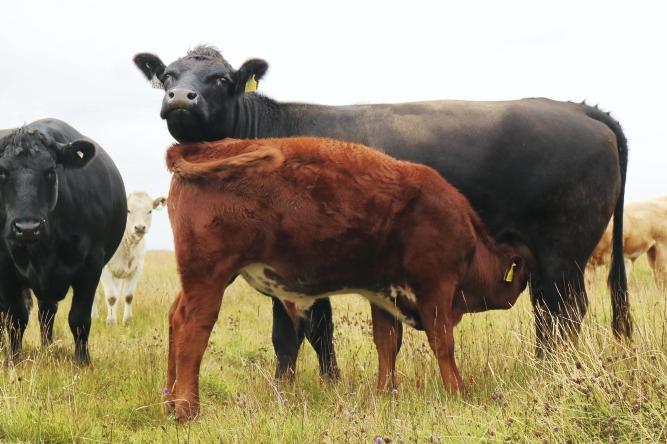Heavy rain across the country over the last few days has seen ground conditions deteriorate in many areas and the forecast for the coming week shows little sign of improvement. During periods of constant rain, grass dry matter (DM) becomes significantly lower – anywhere between 10% – 12% DM. For comparison sake, during a week of dry weather, grass would normally be 18% – 20%DM.
This means in every bite of grass a cow takes during periods of wet weather, they are taking in over 40% less dry matter than in normal conditions.
This puts a huge nutritional strain on animals, as they need to eat a lot more grass to achieve the same level of nutrition. In a lot of cases, the animal is unable to do so, due to the physical mass of grass needed.
Where nutritional demands are not being met by grass intake, cows will have to use their own body reserves to make up the difference.
First-calved heifers
We ask a lot of first-calved heifers, especially where they calve down at 24 months old. They are being asked to feed a calf and maintain a pregnancy, while at the same time, trying to reach their own mature liveweight.
If nothing is done, these heifers will lose excessive condition over the next month to six weeks. This will mean having to feed meal to cows during the winter to recover body condition, or result in thin cows in the run-up to calving next spring, which can bring with it its own list of problems.
For this reason, when the weather conditions are against them, we need to step in and give them a helping hand.
Supplement the calf:The calf at foot will be putting a huge strain on cows at this time of year as they get heavier. Remember that in periods of poor weather, the proportion of the diet that they eat as grass will also be significantly lower on a dry matter basis – this will make them even more keen to suck the cow, increasing the pressure she is under. Offering the calf 2kg – 3kg of concentrate will see a good return in terms of the cost of feed versus the extra liveweight gained by the calf. Feeding concentrate to the calf now makes more sense than having to feed a thin cow during the winter period.Better-quality grass: Is there an option to offer first-calved heifers and any other thinner cows better-quality grazing compared to the rest of the cows? Splitting them out to a smaller batch and not making them work as hard cleaning out paddocks will help ease some of the nutritional pressure. Wean the calf early: If poor weather and grazing conditions persist, be prepared to wean these first-calved heifers earlier than the main batch of cows. This will give the cow more time to recover over winter, prior to calving next spring.
Heavy rain across the country over the last few days has seen ground conditions deteriorate in many areas and the forecast for the coming week shows little sign of improvement. During periods of constant rain, grass dry matter (DM) becomes significantly lower – anywhere between 10% – 12% DM. For comparison sake, during a week of dry weather, grass would normally be 18% – 20%DM.
This means in every bite of grass a cow takes during periods of wet weather, they are taking in over 40% less dry matter than in normal conditions.
This puts a huge nutritional strain on animals, as they need to eat a lot more grass to achieve the same level of nutrition. In a lot of cases, the animal is unable to do so, due to the physical mass of grass needed.
Where nutritional demands are not being met by grass intake, cows will have to use their own body reserves to make up the difference.
First-calved heifers
We ask a lot of first-calved heifers, especially where they calve down at 24 months old. They are being asked to feed a calf and maintain a pregnancy, while at the same time, trying to reach their own mature liveweight.
If nothing is done, these heifers will lose excessive condition over the next month to six weeks. This will mean having to feed meal to cows during the winter to recover body condition, or result in thin cows in the run-up to calving next spring, which can bring with it its own list of problems.
For this reason, when the weather conditions are against them, we need to step in and give them a helping hand.
Supplement the calf:The calf at foot will be putting a huge strain on cows at this time of year as they get heavier. Remember that in periods of poor weather, the proportion of the diet that they eat as grass will also be significantly lower on a dry matter basis – this will make them even more keen to suck the cow, increasing the pressure she is under. Offering the calf 2kg – 3kg of concentrate will see a good return in terms of the cost of feed versus the extra liveweight gained by the calf. Feeding concentrate to the calf now makes more sense than having to feed a thin cow during the winter period.Better-quality grass: Is there an option to offer first-calved heifers and any other thinner cows better-quality grazing compared to the rest of the cows? Splitting them out to a smaller batch and not making them work as hard cleaning out paddocks will help ease some of the nutritional pressure. Wean the calf early: If poor weather and grazing conditions persist, be prepared to wean these first-calved heifers earlier than the main batch of cows. This will give the cow more time to recover over winter, prior to calving next spring. 





 This is a subscriber-only article
This is a subscriber-only article










SHARING OPTIONS: